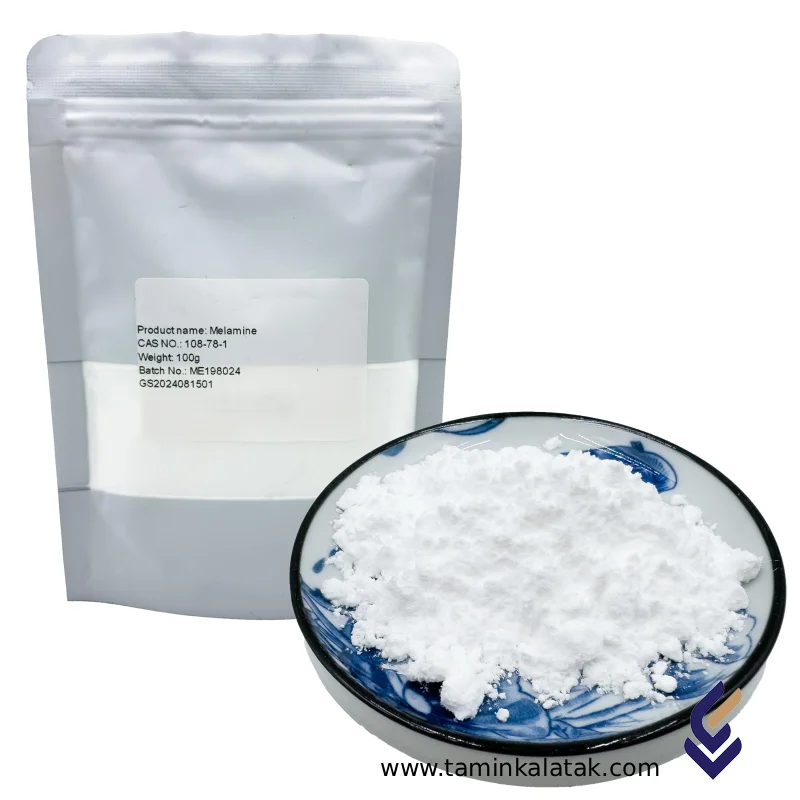Melamine
Melamine is a nitrogen-rich heterocyclic organic compound with the molecular formula C₃H₆N₆.
It consists of a 1,3,5-triazine ring substituted with three amino groups.
Due to its high nitrogen content (≈66%), melamine is a key raw material for producing melamine–formaldehyde resins, which are valued for their hardness, durability, and heat resistance.
Melamine plays an important role in various industries such as resin manufacturing, laminates, molded plastics, cement additives, and flame-retardant coatings, making it a high-demand product in the construction and chemical sectors.
Chemical Structure
-
Molecular Formula: C₃H₆N₆
-
Chemical Structure: 1,3,5-triazine ring with three amino groups at positions 2, 4, and 6
-
IUPAC Name: 1,3,5-triazine-2,4,6-triamine
-
CAS Number: 108-78-1
Physical and Chemical Properties
| Property | Typical Value |
|---|---|
| Appearance | White crystalline powder or dry granules |
| Density (20°C) | 1.57 g/cm³ |
| Melting Point | 345°C (with decomposition) |
| Vapor Pressure (ambient) | Negligible (<0.01 Pa) |
| Water Solubility | 3.2 g/L at 20°C; 24 g/L at 90°C |
| Nitrogen Content | ~66% by weight |
| Thermal Stability | Decomposes at high temperatures releasing nitrogen gas, providing flame-retardant properties |
Key Advantages
-
Produces hard, scratch-resistant resins (e.g., laminates and Formica® panels)
-
Excellent resistance to heat, moisture, and impact
-
Smooth, glossy surface with long-lasting durability
-
Flame-retardant behavior due to nitrogen gas release during combustion
-
Effective flame-retardant additive in polymers and cement formulations
Limitations and Hazards
-
Toxicity in humans and animals: may cause kidney stones (especially with cyanuric acid exposure)
-
Potential liver and kidney damage with chronic exposure
-
Possible carcinogenicity observed in animal studies
-
Dust inhalation hazard: irritates skin, eyes, and respiratory tract
-
Dust explosion risk in storage or processing areas
-
Low solubility in cold water, limiting use in aqueous systems
Industrial Applications
-
Melamine–Formaldehyde Resin:
Used in MDF, decorative laminates, industrial adhesives, heat-resistant tableware, and kitchenware. -
Melamine Foam:
Applied in cleaning sponges (Magic Erasers), sound and thermal insulation materials. -
Flame Retardant Additive:
Incorporated into paints, coatings, polymers, and concrete to reduce flammability. -
Slow-Release Nitrogen Fertilizer:
Limited agricultural use due to high cost and slow decomposition rate in soil.
Safety and Handling
Main Hazards:
-
Oral toxicity: LD₅₀ (rat) ≈ 3161 mg/kg
-
Respiratory and eye irritation
-
Possible kidney damage after long-term exposure
Personal Protective Equipment (PPE):
-
N95 or FFP2 dust mask
-
Safety goggles
-
Chemical-resistant gloves
-
Protective clothing to prevent dust contact
Storage Conditions:
-
Keep in a cool, dry, well-ventilated area
-
Store away from oxidizing agents
-
Use sealed, clearly labeled containers
-
Avoid dust formation and dispersion
Emergency Measures:
-
Skin contact: Wash thoroughly with soap and water
-
Eye contact: Rinse immediately with clean water for at least 15 minutes
-
Inhalation: Move to fresh air immediately
-
Ingestion: Seek medical attention; do not induce vomiting
Melamine is an essential industrial compound known for its high nitrogen content, flame-retardant behavior, and resin-forming capability.
It remains a cornerstone material in resin production, laminates, and high-performance coatings, provided it is handled under proper safety and environmental protocols.
Applications
| Applications | , , , |
|---|
Melamine
| Products | Chemical formula | CAS number | Grade | Vapor pressure | Physical appearance | Density (at 20°C) | Solubility in water | Melting point |
|---|---|---|---|---|---|---|---|---|
| (Melamine) | C₃H₆N₆ | 108-78-1 | (Industrial Grade), (Laboratory Grade) | Very small (< 0.01 Pa) | White crystalline powder or dry granules | 1.57 g/cm³ | 3.2 g/L at 20°C – about 24 g/L at 90°C | About 345°C (with decomposition) |







